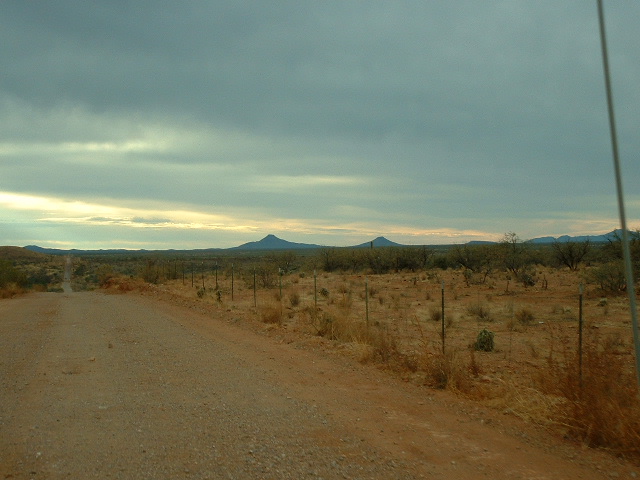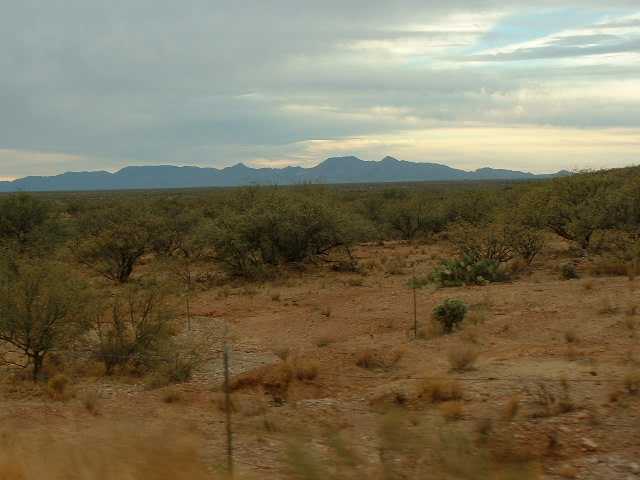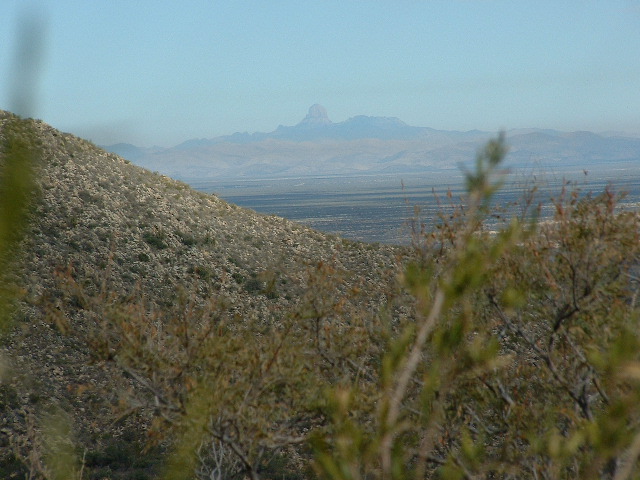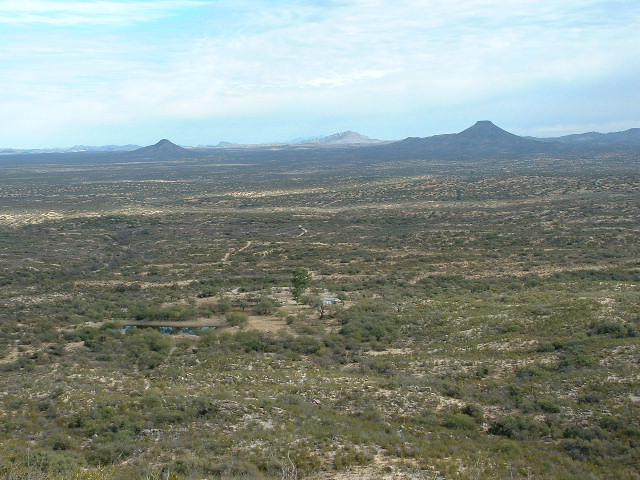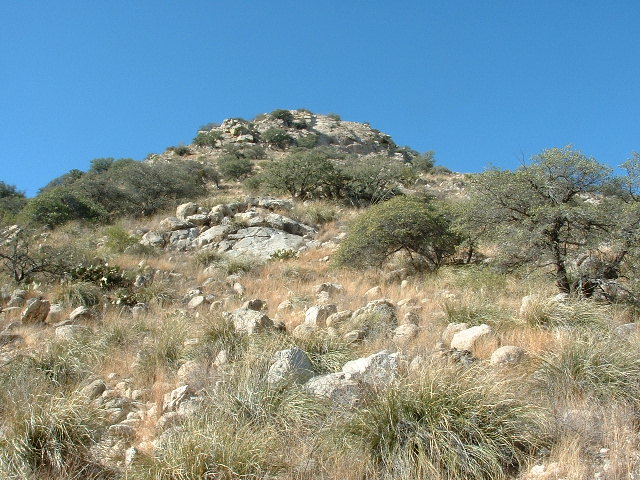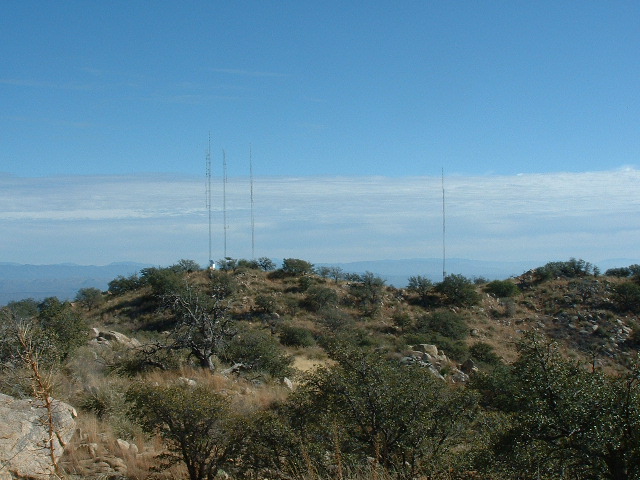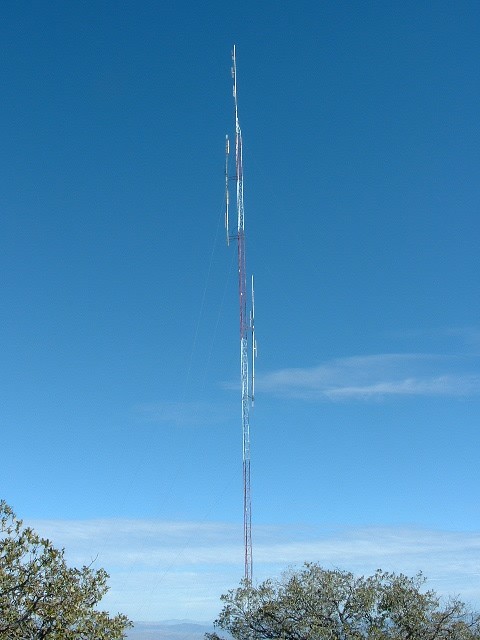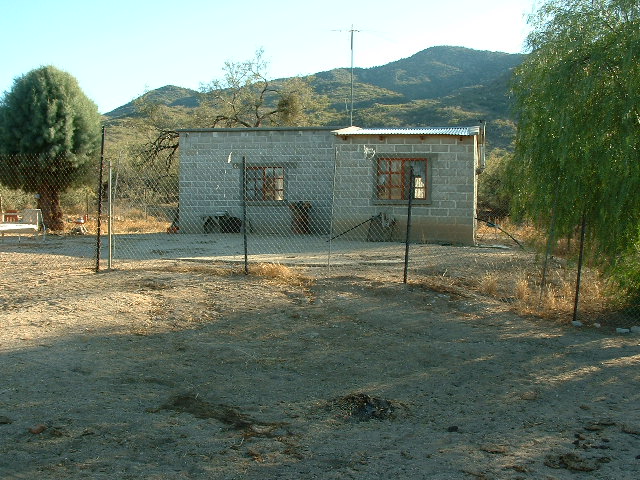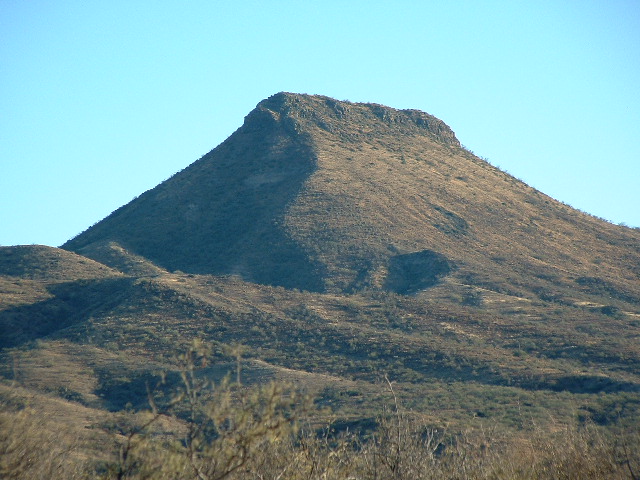On January 1, 2007, New Year’s Day, I met Andy Martin in southwest Tucson at about 6:15 AM. It was still dark. I put all my stuff into his vehicle, locked up mine, and away we drove in his Mitsubishi. We travelled for about an hour and arrived at the tiny community (population 50) of Sasabe, Arizona. The border crossing doesn’t open until 8:00 AM, so we had to wait for half an hour. We were the first ones through. The Mexican customs official asked us a few questions and then let us continue. We were now in the town of Sasabe in the Mexican state of Sonora.
This is one of the border towns that God forgot. It is a well-known fact in these parts that Sasabe’s sole raison-d’être nowadays is as a jumping-off point for those planning to cross illegally into the U.S., either to find work or to transport drugs to the waiting throngs of American users. Without those activities, the town would surely dry up and blow away.
This place has a few thousand inhabitants, so it is much larger than its Arizona counterpart. But a more depressing place on the face of this earth it would be hard to find. The dirt streets are lined with shabby shops and residences. The whole place simply oozes despair, frustration and abject poverty. The only claim to fame of Sasabe is that it is a major jumping-off point for desperate border-crossers who want to cross illegally into the United States. In recent years, many flop-houses have sprung up, with the sole purpose of sheltering for a few nights those who are getting ready to play their deadly cat-and-mouse game with the US Border Patrol. Even worse, it is a center for the smuggling of drugs into the US. Shops sell everything one could possibly need to feed, hydrate, clothe and shelter a person who wants to sneak across the border. Even the town cemetery is famous for its graves of drug smugglers, big and small, who have died here. “Coyotes”, or guides who smuggle illegal entrants into the US, abound here as well. It takes a while to get through town, negotiating the rough, twisty streets, which are so bad that it’s hard to imagine how any vehicle could last beyond a few years. If it sounds like I’m being overly unkind to Sasabe, I’m not – in fact, this description has been rather generous.
Once at the southern edge of town, the road improves – it becomes a dirt highway which heads south for about 65 miles to Altar, Sonora. It stays in mountainous country for a few miles, but about 6 miles from the border we left this main road to head southeast on another dirt road which makes its way to the town of Saric. We crossed fairly flat country for about 17 miles on this road, and the landscape was dotted with dramatic volcanic cones.
About 23 miles from Sasabe, we left this road and headed south through rugged country on a lesser road and arrived 8 miles later at the tiny community of San Juan down in a hollow. Thanks to Andy’s excellent use of Google Earth air photos, we easily negotiated our way through and out of the hamlet on to the last roads we needed. Another 4 miles of driving had us parked at the end of the road at a tiny ranch house. This spot actually bears the name “Granaditos” on the Mexican 1:50,000 topo map, which means “little pomegranate trees”. There was nobody home, so we parked in their yard and left a New Year’s greeting on a piece of paper on the windshield in case they returned. The map showed that we were at about 3,250′ elevation, or close to 990 meters.
It was about 10:20 AM when we started walking. After leaving the house and its corrals, we headed southwest up brushy slopes to a saddle at about 4,170′. As we did so, the overcast day turned into a bright, sunny one. Something on the distant horizon caught our attention – it was the striking silhouette of Baboquivari Peak in Arizona, 40 miles distant.
As we climbed the slope, we could see back down to the ranch house and its pond.
Once above the saddle, we climbed south up a ridge for a short while. Andy decided he’d like to drop down for a bit into a gully, which he did, while I continued climbing up the ridge in a cold breeze. Before long, we both met at another saddle (ominously named “Puerto el Diablo” or “Devil’s Pass” on the map) at about 4,760′. We stashed some water here, then continued up the steep slope.
Before long, we had arrived at the summit area where we found four antennae, each about 60 to 80 feet tall and in very good condition compared to the dilapidated junk that is often found on Mexican peaks.
Andy had warned that there were five areas on this highest part of the Sierra San Juan which were all bounded by a similar closed 1,620-meter contour. We could tell right away that the first one we stood on was not the highest so we went over to the second one. It was higher, but the more distant third one looked possibly higher through both of our hand levels, or at least was too close to call. So, away we went to the third bump. Once there, it was difficult to say if the fourth bump were higher or not, so away we went to the fifth. One thing that could be said for sure was that the fifth and final bump was lower than the fourth. After traipsing around on this mile-long summit area, we concluded that the second bump was the highest after all. This interpolates to 5,348′ elevation. We left a register there. The summit is named “Loma el Encinal” on the topo map. Encinal is a type of evergreen oak tree, and these were common on the upper parts of the mountain. It’s important to know at this point that the Mexican 1:50,000-scale topo maps that we were using show different details than what Google Maps shows on the link I’ve provided.
By the time we shoved off from the summit, it was after 2:00 PM. We made good time descending, but you couldn’t really avoid the catclaw-infested brush. It took about two hours to get back to the truck. Andy had worn short sleeves, and his arms looked like someone had gone at him with razor wire. Here’s the little house by which we’d parked.
And here’s a shot of our trusty ride for the trip, Andy’s Mitsubishi.
From our parking spot, we had this great view back to our nice-looking peak, Loma El Encinal. The summit ridge with the 5 contenders for the high point was a mile long.
It took about two hours to drive all the way back to Sasabe. We had a self-imposed deadline of 8:00 PM to get out of Mexico, because that was when the Sasabe border crossing closed for the night. We got there at 6:00 PM, in plenty of time, and were back in Tucson before 8 o’clock.
Here’s an alarming footnote to this story – the source was Channel 12 in Phoenix, Arizona.
12 News
Jan. 4, 2007 02:44 PM
National Guard unit stormed while patrolling the border
A U.S. Border Patrol Entry Identification Team site was overrun Wednesday night along Arizona’s border with Mexico.
According to the Border Patrol, an unknown number of gunmen attacked the site in the state’s West Desert Region around 11 p.m. The site is manned by National Guardsmen. Those guardsmen were forced to retreat.
The Border Patrol will not say whether shots were fired. However, no Guardsmen were injured in the incident.
The Border Patrol says the incident occurred somewhere along the 120-mile section of the border between Nogales and Lukeville. The area is known as a drug corridor. Last year, 124,000 pounds of illegal drugs were confiscated in this area.
The Border Patrol says the attackers quickly retreated back into Mexico
Readers, how outrageous can things get? What you just read happened only 3 days after our climb. There is a real threat, and it’s right here on our southern border. To give you perhaps an even scarier example of the dangers present in this area, I am including here an excerpt from a story published by Borderland Beat, which reports on the Mexican cartel drug war. This was originally published on July 3, 2010. What you are about to read happened just a few miles southeast of where Andy and I did this climb.
The unofficial death toll for Thursday morning’s battle between rival organized criminal groups has reached 29 according to reports coming out of the Nogales, Sonora area. The shootout occurred approximately 12 miles south of the little used border crossing point in the town of Sasabe, Arizona, located in Pima County.
According to Mexican press reports and official statements a large group of gunmen affiliated with the Sinaloa cartel and traveling in more than fifty vehicles was ambushed on the road to Sasabe between the small towns of Tubutama and Saric.
Since Wednesday evening, residents of the neighboring towns reported a high number of pickup trucks and SUVs traveling on the roads leading to Tubutama. By some estimates close to 100 vehicles assembled in Tubutama Wednesday night where X’s were painted on the windows and red cloths were attached to car doors and rear bumpers for identification purposes.
There are rumors that several active and former members of the Nogales police force were present in the group of armed men. The convoy left Tubutama heading north on the desolate road to Saric early Thursday morning. The purpose of the army of gunmen was a “cleansing operation” to dislodge a rival organized crime group that had seized the trafficking route from Saric north to the Arizona border. According to sources this group in Saric is aligned with the Beltran Leyva cartel and had already survived several encounters with Mexican army troops and federal police.
Residents reported a tremendous level of gunfire between 4:00 and 5:00 AM Thursday on the outskirts of Saric. According to statements from the state prosecutor’s office, the group of gunmen traveling in the convoy was ambushed in an area where hills straddle the roadway by the rival group which had dug in on the high ground and directed a withering crossfire on the vehicles.
Municipal police were alerted and arrived first and were greeted by the carnage at the ambush site. At least 10 vehicles littered the roadway and the dead were laying on the road and inside their destroyed vehicles. State police and army troops arrived soon after and sealed off the area to initiate the investigation and search for any remaining gunmen from either camp. Ten men were taken into custody at the scene. Six of those arrested suffered non life threatening wounds. Two of those arrested were minors, one 15 year old and one 17 year old.
Official statements from the state prosecutor’s office put the death toll at 21 but observers at the scene said the number of deaths was much higher. The local media was removed from the scene as soon as the army arrived. Several of the dead gunmen were reported to be from the states of Sinaloa and Tamaulipas. As of Friday the area was still sealed off by roadblocks of army troops and police. It was not known if the border crossing between the towns of Sasabe, Sonora and Sasabe, Arizona was temporarily closed.
It is in part due to the growing instability and lawlessness in Sonora and the border area that Arizona’s tough new immigration bill, SB 1070, was passed into law.
Southern Arizona serves as a major drug and human trafficking route for the rest of the nation. More than half of all illegal immigrants and drugs are apprehended on the Arizona border.
In recent months the level of violence in Arizona from Mexican smuggling operations has increased as the dispute between rival traffickers for the lucrative smuggling routes has spread north into the U.S. The violence is mostly limited to encounters between traffickers stealing drug loads and kidnapping undocumented persons from rival smugglers.
Ranchers and residents in the sparsely populated areas of southern Arizona now say that drug loads and groups of undocumented aliens are escorted by armed guards.
As I’ve said many times before, there’s never a dull moment on our border area.

